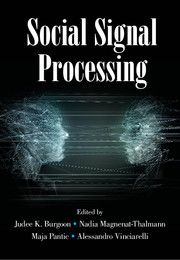Book contents
- Frontmatter
- Contents
- Contributors
- 1 Introduction: Social Signal Processing
- Part I Conceptual Models of Social Signals
- 2 Biological and Social Signaling Systems
- 3 Universal Dimensions of Social Signals: Warmth and Competence
- 4 The Vertical Dimension of Social Signaling
- 5 Measuring Responses to Nonverbal Social Signals: Research on Affect Receiving Ability
- 6 Computational Analysis of Vocal Expression of Affect: Trends and Challenges
- 7 Self-presentation: Signaling Personal and Social Characteristics
- 8 Interaction Coordination and Adaptation
- 9 Social Signals and Persuasion
- 10 Social Presence in CMC and VR
- Part II Machine Analysis of Social Signals
- Part III Machine Synthesis of Social Signals
- Part IV Applications of Social Signal Processing
- References
9 - Social Signals and Persuasion
from Part I - Conceptual Models of Social Signals
Published online by Cambridge University Press: 13 July 2017
- Frontmatter
- Contents
- Contributors
- 1 Introduction: Social Signal Processing
- Part I Conceptual Models of Social Signals
- 2 Biological and Social Signaling Systems
- 3 Universal Dimensions of Social Signals: Warmth and Competence
- 4 The Vertical Dimension of Social Signaling
- 5 Measuring Responses to Nonverbal Social Signals: Research on Affect Receiving Ability
- 6 Computational Analysis of Vocal Expression of Affect: Trends and Challenges
- 7 Self-presentation: Signaling Personal and Social Characteristics
- 8 Interaction Coordination and Adaptation
- 9 Social Signals and Persuasion
- 10 Social Presence in CMC and VR
- Part II Machine Analysis of Social Signals
- Part III Machine Synthesis of Social Signals
- Part IV Applications of Social Signal Processing
- References
Summary
The pace of research devoted to the study of social and emotional intelligence has escalated exponentially (Bar-On & Parker, 2000; Goleman, 2006; Mayer & Salovey, 1997; Salovey & Mayer, 1990), and the upsurge in interest has intensified the need to understand social signals, whose production and deciphering may be strongly affected by these various intelligences (Gardner, 1983). Social signals have been conceptualized in a variety of ways, but as social psychologists, we define a social signal as any variable associated with a communicative act, excluding its written or spoken content, that carries meaning. The signal may be intentionally or unintentionally encoded by a source, and mindfully or mindlessly decoded by a receiver. This definition acknowledges and allows for the smile or smirk that accompanies the expression, “You look good today,” or the falling intonation of the word “today,” to carry more meaning than the actual content of the declaration. By this definition, research on communication and persuasion from its inception has focused on understanding social signal effects. Research designed to investigate the credibility of a source of a persuasive message, for example, often relied upon extra-communication features (age, sex, dress, apparent success, etc.) to signal the extent to which a receiver should ponder or trust the information provided by the source. The speed of speech, attractiveness of the source, and the animation of the speaker all have strong effects on persuasion. This is true even when the content of the verbal or written communication remains constant across experimental conditions.
In experimental research, the social signal is considered from the vantage point of the encoder, or in other terms, as an independent variable. As such, failures to obtain differences attributable to signal variations often were counted as manipulation breakdowns. Less frequently, researchers have focused on the receivers of social signals, and sometimes the interactive behaviors of both encoders and decoders are examined in tandem. In one such study, college-age men were led to believe that a young woman with whom they were to converse via telephone was either beautiful or plain (Snyder, Tanke, & Berscheid, 1977).
- Type
- Chapter
- Information
- Social Signal Processing , pp. 97 - 109Publisher: Cambridge University PressPrint publication year: 2017



